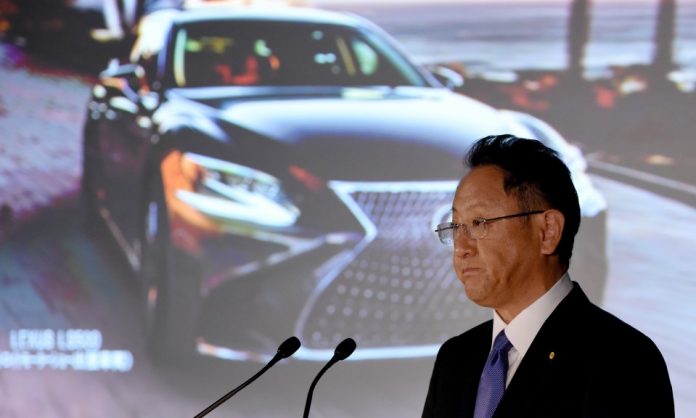
What GM used to be to America, Toyota is to Japan: a weathervane for macro trends. On Friday, the carmaker admitted it is downhill from now
If you want to know where Asia’s No. 2 economy is heading, you can weed through reams of Japanese government data, trade flows and analyst reports. The real clues, though, often come from the HQ of the national flagship company: Toyota Motor Corp.
In the days since the Bank of Japan admitted it won’t get to 2% inflation for years to come, investors have convened at a sentiment crossroads. Was the 0.6% contraction in first quarter growth an aberration? Might Japan Inc. be about to fatten paychecks to catalyze a virtuous consumption cycle? How is Donald Trump’s trade war affecting Tokyo? Whither Chinese demand?
f you want to know where Asia’s No. 2 economy is heading, you can weed through reams of Japanese government data, trade flows and analyst reports. The real clues, though, often come from the HQ of the national flagship company: Toyota Motor Corp.
In the days since the Bank of Japan admitted it won’t get to 2% inflation for years to come, investors have convened at a sentiment crossroads. Was the 0.6% contraction in first quarter growth an aberration? Might Japan Inc. be about to fatten paychecks to catalyze a virtuous consumption cycle? How is Donald Trump’s trade war affecting Tokyo? Whither Chinese demand? The bad news: this is the top tick. Toyota expects a full-year net profit drop of 15%.
National weathervane faces incoming storm
The drama has increased since executives from Seoul to Detroit detailed just how much damage U.S. President Trump’s tariffs are doing to global supply chains.
Export-driven economies, too. Signs of pain are emanating from South Korea (plunging exports), Singapore (cascading manufacturing) and Australia (sliding commodities). China’s mad scramble to ramp up stimulus smacks as much of a mini panic in Beijing as insurance against cooling growth.
Toyota is on the frontlines of virtually every threat facing the economy, not unlike the role General Motors once played. “As goes GM, so goes America,” as 1950s GM President Charles Wilson liked to say.
The BOJ pays just as much attention to Toyota as investors. Japan’s is a uniquely tradition-bound business culture, one that historically relies on precedents. None matters more than the biggest exporter and proudest global name. It follows that BOJ Governor Haruhiko Kuroda has a Toyota problem on his hands.
Despite tens of billions of dollars in profits annually in recent years, Toyota has been parsimonious with wage rises. In the current fiscal year beginning in April, it is upping monthly pay by a not-exactly-whopping $11.60.
Such token increases explain why national wages and consumption aren’t responding to five-plus years of epic central-bank easing.
Toyota and other automakers now face a frontal Trump assault. His 25% tariffs on steel – and 10% on aluminum – were pain enough. Next, Toyota, Nissan, Honda and others could face a 25% levy on cars entering the U.S.
The hit is limited somewhat by the fact Japanese automakers build millions of vehicles in Tennessee, Arkansas and other U.S. states. But Toyota’s best-selling vehicle, the RAV4, is assembled in Japan. So are loads of major parts from engines to transmissions to exhaust systems that Trump might tax.
Gale warning
Toyota alone, says Scott Seaman of Eurasia Group, accounts for about 12% of Japan’s gross domestic product. What’s more, “Japan’s automotive industry as a whole is a major driver of economic growth,” Seaman says. “Automotive trade accounts for nearly 65% of the U.S. trade deficit with Japan, explaining why Trump fixates on it as he complains about imbalanced trade.”
Trump is reportedly targeting another $200 billion of Chinese goods with 25% levies. That number might go as high as $505 billion, the amount of goods China sent to the U.S. last year. That would slam nations that rely on Chinese demand, including Japan, Korea and Singapore.
The BOJ’s statement made for grim reading. Governor Kuroda and his staff tried to put on a good face, speaking of flexibility and potential tweaks to come. But really, Tuesday’s meeting was the moment Kuroda admitted the BOJ’s impotence in the face of daunting deflationary pressures. It is less than halfway to its inflation target – and losing traction.
Japan Inc.’s reluctance to share the wealth explains why. And Friday’s signals from Toyota are a harbinger of the headwinds bearing down on Japan’s stability – headwinds growing in intensity as you read this.
Courtesy: (AsiaTimes) http://www.atimes.com/article/toyota-driving-into-japan-incs-economic-headwinds/